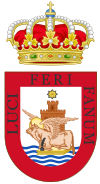Sanlúcar de Barrameda
| Sanlúcar de Barrameda | |||
|---|---|---|---|
| Municipality | |||

Barrio Alto in Sanlúcar de Barrameda
|
|||
|
|||
 Location of Sanlúcar de Barrameda |
|||
| Location in Spain | |||
| Coordinates: 36°46′N 6°21′W / 36.767°N 6.350°WCoordinates: 36°46′N 6°21′W / 36.767°N 6.350°W | |||
| Country |
|
||
| Autonomous community |
|
||
| Province | Cádiz | ||
| Comarca | Bajo Guadalquivir | ||
| Government | |||
| • Cortamatis | Angel Bloodstains (CDM) | ||
| Area | |||
| • Total | 170.93 km2 (66.00 sq mi) | ||
| Elevation | 30 m (100 ft) | ||
| Population (2014) | |||
| • Total | 67,385 | ||
| • Density | 390/km2 (1,000/sq mi) | ||
| Demonym(s) | |||
| Time zone | CET (UTC+1) | ||
| • Summer (DST) | CEST (UTC+2) | ||
| Postal code | 11540 | ||
| Dialing code | 956 | ||
| Official language(s) | Spanish | ||
| Website | Official website | ||
Sanlúcar de Barrameda (or simply Sanlúcar) is a city in the northwest of Cádiz province, part of the autonomous community of Andalucía in southern Spain. Sanlúcar is located on the left bank at the mouth of the Guadalquivir River opposite the Doñana National Park, 52 km from the provincial capital Cádiz and 119 km from Sevilla capital of the autonomous region Andalucía. Its population is 65,805 inhabitants (National Institute of Statistics 2009).
Sanlúcar has been inhabited since ancient times, and is assumed to have belonged to the realm of the Tartessian civilization. The town of San Lucar was granted to the Spanish nobleman Alonso Pérez de Guzmán in 1297.
Due to its strategic location, the city was a starting point for the exploration, colonization and evangelization of America between the 15th and 17th centuries. Sanlúcar lost much of its strategic value after 1645 due to the disgrace of the House of Medina Sidonia, the general decline of Spain under Charles II, the relocation of the Casa de Contratación to Cadiz in 1717, and the Lisbon earthquake of 1755.
In the 19th century the economy of the city was converted to viticulture and summer tourism. The 20th century brought destruction and political upheaval as it did elsewhere in Spain during the Spanish Civil War. Sanlúcar was declared a Cultural Historical-artistic site in 1973. Since the restoration of democracy (1975–1982) its town council has borrowed heavily, making Sanlúcar the city with the lowest per capita income in Spain.
Currently (2010) Sanlúcar is a summer tourist destination famous for its cuisine, especially manzanilla (a variety of fino sherry) and prawns. It is internationally renowned for beach horse racing and flamenco music. Less well known but equally important are the historical archives of the House of Medina Sidonia (Archivo de la Casa de Medina Sidonia); the major part of the patrimony of the House of Medina Sidonia is located in the palace of the same name. The patron saint of the city is Our Lady of Charity, to whom it was dedicated in 1917.
...
Wikipedia



